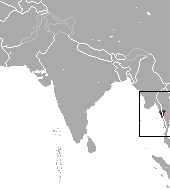Tenasserim langur
| Tenasserim langur | ||||||||||||
|---|---|---|---|---|---|---|---|---|---|---|---|---|
| Systematics | ||||||||||||
|
||||||||||||
| Scientific name | ||||||||||||
| Trachypithecus barely | ||||||||||||
| ( Blyth , 1847) |
The tenasserim langur ( Trachypithecus barbei ) is a little-known primate species from the group of slender monkeys (Presbytini).
The fur of the Tenasserim langurs is black-gray on the back and a little lighter on the belly. The limbs are also as dark as the body. The face is gray with a slight purple tinge, around the eyes there are white circles similar to those of the glasses langur . The head has to for lutung on typical hair.
These primates live in Southeast Asia in the north of the Malay Peninsula in the eponymous region Tenasserim (today Tanintharyi) in Myanmar and in the neighboring regions of Thailand . Forests are their habitat.
Nothing is known about the way of life. Presumably, like the other crested langurs, they are diurnal tree dwellers who live together in groups and feed on leaves and other parts of plants.
The systematic position of the tenasserim langur within the genus of the crested langur is unclear. Wilson & Reeder (2005) classify it in the cristatus group and thus as a close relative of the silver crested langur . Geissmann et al. (2004), on the other hand, see him as a close relative of the spectacle langur and thus in the obscurus group.
literature
- Thomas Geissmann, Colin P. Groves, Christian Roos: The Tenasserim Lutung, Trachypithecus barbei (Blyth, 1847) (Primates: Cercopithecidae): Description of a live specimen, and a reassessment of phylogenetic affinities, taxonomic history, and distribution. In: Contributions to Zoology. 73, 4, 2004, ISSN 0067-8546 , pp. 271-282, PDF
- Don E. Wilson, DeeAnn M. Reeder (Eds.): Mammal Species of the World. A taxonomic and geographic Reference. Johns Hopkins University Press, Baltimore MD 2005, ISBN 0-8018-8221-4 .
Web links
- Information on Theprimata.com
- Trachypithecus barbei in the Red List of Threatened Species of the IUCN 2013.1. Listed by: Groves, CP, Brockelman, W. & Geissman, T., 2008. Retrieved September 17, 2013.
